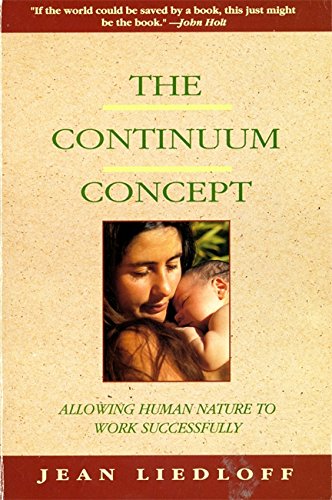From the website, The Continuum Concept
According to Jean Liedloff, the continuum concept is the idea that in order to achieve optimal physical, mental and emotional development, human beings — especially babies — require the kind of experience to which our species adapted during the long process of our evolution. For an infant, these include such experiences as…
- constant physical contact with his mother (or another familiar caregiver as needed) from birth;
- sleeping in his parents’ bed, in constant physical contact, until he leaves of his own volition;
- breastfeeding “on cue” — nursing in response to his own body’s signals;
- being constantly carried in arms or otherwise in contact with someone, usually his mother, and allowed to observe (or nurse, or sleep) while the person carrying him goes about his or her business — until the infant begins creeping, then crawling on his own impulse, usually at six to eight months;
- having caregivers immediately respond to his signals (squirming, crying, etc.), without judgment, displeasure, or invalidation of his needs, yet showing no undue concern nor making him the constant center of attention;
- sensing (and fulfilling) his elders’ expectations that he is innately social and cooperative and has strong self-preservation instincts, and that he is welcome and worthy.
In contrast, a baby subjected to modern Western childbirth and child-care practices often experiences…
- traumatic separation from his mother at birth due to medical intervention and placement in maternity wards, in physical isolation except for the sound of other crying newborns, with the majority of male babies further traumatized by medically unnecessary circumcision surgery;
- at home, sleeping alone and isolated, often after “crying himself to sleep”;
- scheduled feeding, with his natural nursing impulses often ignored or “pacified”;
- being excluded and separated from normal adult activities, relegated for hours on end to a nursery, crib or playpen where he is inadequately stimulated by toys and other inanimate objects;
- caregivers often ignoring, discouraging, belittling or even punishing him when he cries or otherwise signals his needs; or else responding with excessive concern and anxiety, making him the center of attention;
- sensing (and conforming to) his caregivers’ expectations that he is incapable of self-preservation, is innately antisocial, and cannot learn correct behavior without strict controls, threats and a variety of manipulative “parenting techniques” that undermine his exquisitely evolved learning process.
Evolution has not prepared the human infant for this kind of experience. He cannot comprehend why his desperate cries for the fulfillment of his innate expectations go unanswered, and he develops a sense of wrongness and shame about himself and his desires. If, however, his continuum expectations are fulfilled — precisely at first, with more variation possible as he matures — he will exhibit a natural state of self-assuredness, well-being and joy. Infants whose continuum needs are fulfilled during the early, in-arms phase grow up to have greater self-esteem and become more independent than those whose cries go unanswered for fear of “spoiling” them or making them too dependent.
Here are some excerpts from the book which define the continuum concept:
…It is no secret that the “experts” have not discovered how to live satisfactorily, but the more they fail, the more they attempt to bring the problems under the sole influence of reason and disallow what reason cannot understand or control.
We are now fairly brought to heel by the intellect; our inherent sense of what is good for us has been undermined to the point where we are barely aware of its working and cannot tell an original impulse from a distorted one.
…[Determining what is good for us] has for many millions of years been managed by the infinitely more refined and knowledgeable areas of the mind called instinct. … [The] unconscious can make any number of observations, calculations, syntheses, and executions simultaneously and correctly.
…What is meant here by “correct” is that which is appropriate to the ancient continuum of our species inasmuch as it is suited to the tendencies and expectations with which we have evolved. Expectation, in this sense, is founded as deeply in man as his very design. His lungs not only have, but can be said to be, an expectation of air, his eyes are an expectation of light… [etc.]
…The human continuum can also be defined as the sequence of experience which corresponds to the expectations and tendencies of the human species in an environment consistent with that in which those expectations and tendencies were formed. It includes appropriate behavior in, and treatment by, other people as part of that environment.
The continuum of an individual is whole, yet forms part of the continuum of his family, which in turn is part of his clan’s, community’s, and species’ continua, just as the continuum of the human species forms part of that of all life.
…Resistance to change, no way in conflict with the tendency to evolve, is an indispensable force in keeping any system stable.
What interrupted our own innate resistance to change a few thousand years ago we can only guess. The important thing is to understand the significance of evolution versus (unevolved) change. … [The latter] replaces what is complex and adapted with what is simpler and less adapted.
There is no essential difference between purely instinctive behavior, with its expectations and tendencies, and our equally instinctive expectation of a suitable culture, one in which we can develop our tendencies and fulfill our expectations, first, of precise treatment in infancy, and gradually of a (more flexible) kind of treatment and circumstance, and a range of requirements to which adaptation is ready, eager, and able to be made.
pp. 22-27, The Continuum Concept, Revised edition ©1977, 1985 by Jean Liedloff, published by Addison-Wesley, paperback, 20th printing.
Related Articles by Jean Liedloff
- The Importance of the In-Arms Phase
- Who’s In Control? The Unhappy Consequences of Being Child-Centered



Comments are closed.